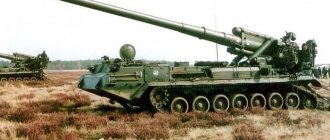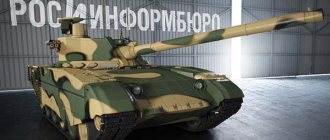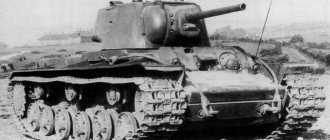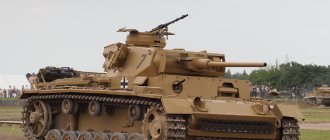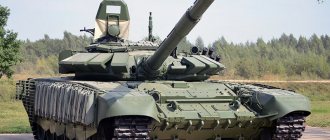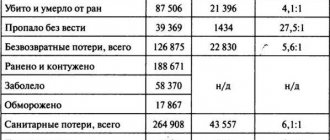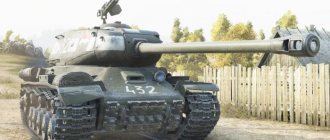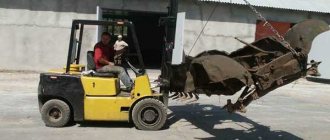A flying tank is not a whim of Soviet designers, but an urgent need of pre-war and war times. In an attempt to overcome the force of gravity and strengthen the country's military power, aircraft and weapons designers joined forces in different design bureaus. For example, attaching wings to a combat vehicle or creating flying tanks for the USSR army was already a priority in the late 1930s.
The main objective of war is the rapid and crushing destruction of enemy manpower and military equipment. A flying tank would help cope with entire armies several times faster, designer P. I. Grokhovsky decided. It was he who developed the suspension for transporting light T-27 wedges under the belly of the TB-3 heavy bomber. According to the plan, the wedge was gliding on a huge parachute with a dome diameter of 30 meters.
The idea did not take root, everything was very cumbersome and slow, but the drawings in the archives and prototype models remained. To many ignorant people in the late thirties, it seemed that Grokhovsky was simply fooling around, wasting administrative and financial resources. His parachute wedges were called the “dead-end branch,” but the history of the flying tank in the USSR was just beginning.
Stuka's rival
The war in the skies of Spain showed that a successful shot from an anti-aircraft gun can destroy even an invincible ace, and powerful air defense can complicate the work of aviation in general.
Aircraft designer Ilyushin wrote to Stalin that Soviet fighters and attack aircraft were not sufficiently protected, and proposed creating a new aircraft invulnerable to machine guns and light artillery. He already had a project.
In the same Spain, the U-87 Stuka dive bomber, which became a symbol of German military power, was baptized by fire. It worked effectively and accurately on the ground, but was defenseless against fighters. Ilyushin came up with a vehicle that combined the striking power of a bomber with the protection of ground armored vehicles. In a memo to the leader, he was the first to call his plane a “flying tank.” Later - and regardless of the designer - the same nickname would be given to the Il-2 by aviators.
Italian self-propelled gun
A contemporary of the Tsar Tank, it was used during the First World War. One of the most mysterious vehicles in the world of tanks, very little information has been preserved on it. It is known, however, that in addition to its large size and unusual appearance, the tank had a cannon that fired 305 mm shells at a range of 17.5 km. Presumably used when shelling Austrian fortifications in the Alps, the further history of the vehicle is unknown.
Italian self-propelled gun
Flying tank
The main and revolutionary feature of the attack aircraft was the armored capsule, which protected the pilot and the vital components of the aircraft: the engine, gas tanks, control system. The 5-mm armor withstood the burst of an aircraft machine gun, and fragments of anti-aircraft shells bounced off the 6-mm lower one. The pilot's back was covered by a centimeter-thick metal plate. Everything else was made of wood - you could use it as much as you wanted.
On hot days, attack aircraft carried dozens of holes in their tails and wings. During the night, technicians patched them up and in the morning the IL-2 was again ready for battle.
The plane resembled a tank not only in protection, but also in weapons. Two cannons, two machine guns and 300 kilograms of bombs could destroy the bridge, disperse an infantry battalion and set fire to a couple of tanks. However, after the very first combat missions, the pilots, through the People's Commissariat of Defense, asked Ilyushin to create a place for the rear gunner. The designer really didn’t want to add 150 kilograms of weight to an already heavy plane, but he complied. So a second crew member and another machine gun appeared on the IL-2. In addition to him, the shooter had 10 aircraft grenades. If a German fighter approached the tail, the shooter pressed the lever, the grenade was dropped by parachute and exploded 150 meters behind the plane. The engine for the two-seater version had to be boosted by 100 horsepower - the previous one did not pull.
Armored ATV
If the James Bond films had started filming in 1899, then this British machine would definitely have become one of agent 007's transport gadgets. With a 1.5 horsepower engine, four wheels, a bicycle saddle and a machine gun cannon, the armored ATV protects only the torso with armor and the driver's head. The cross-country ability of such a vehicle is extremely low, so it never entered mass production.
Armored ATV
Concrete plane
That's what the Germans called Il-2. The attack aircraft passed through dense barrage fire, dropped bombs on the target, and on the way back dispersed the Luftwaffe bombers, showering them with cannon and machine gun fire. Even better than the armor, the aircraft was protected by the ability to fly at low altitude and high speed.
The optimal tactics for the armored car was to approach the target at low level - at an altitude of less than 100 meters, German anti-aircraft gunners did not have time to take aim - descending to 50 meters, dropping bombs and hurricane fire from all barrels. And then move on to the next stage of the battle - hunting for enemy attack aircraft.
— The IL-2 did not have a real bomber sight, but it seems to me that it was not needed. There's no time to aim! The stormtrooper's most accurate weapons are cannons. “Very good 23-mm VYa cannons,” wrote Hero of the Soviet Union Valentin Averyanov.
Il-2 pilots took advantage of the similarity of their aircraft to the U-87 and, lowering the landing gear, positioned themselves behind the Stukas in order to get closer to them or avoid the range of German air defense.
IL-2 attack aircraft
In December 1940, the Il-2 aircraft appeared in the ranks of our aviation. Production of single-seat IL-2s began immediately. As of June 22, 1941, 249 vehicles were produced, 50 were already in active units, another 50 were just about to arrive in their regiments. Despite the small number, the first IL-2 flights took place on June 25. Vehicles of the 74th and 66th ShAP attacked the advancing German columns.
IL-2 is being prepared for takeoff
Source: waralbum.ru
In the very first battles, the shortcomings of the new attack aircraft were quickly revealed - of course, the lack of an onboard gunner, which makes the clumsy Il easy prey for an enemy fighter, and the insufficient effectiveness of bombs. The combat air regiments set out to solve the first problem on their own: using a makeshift method, they cut a hole behind the cockpit where the ShKAS machine gun was placed; a technician or gunsmith took the place of the shooter. This place was nicknamed the “death cabin.” And only in September 1942, new two-seat attack aircraft began to arrive in units. True, the gunner’s cockpit was no longer armored, which led to an average death rate of eight gunners per pilot.
Production of Il-2 attack aircraft at one of the aircraft factories in Kuibyshev, where about 40 aircraft industry enterprises were evacuated
Source: waralbum.ru
But the plane was quickly rearmed. RS-82 or RS-132 rockets were placed under the wings, like the Katyusha. The range of bombs quickly expanded: for example, the 100-kilogram FAB-100 could penetrate the side armor of medium German tanks at close range and knock out welds and rivets. And when PTABs, cumulative anti-tank bombs with a caliber of 1.5–2.5 kilograms, entered service, the Germans were forced to abandon tank attacks in close formation and increase the distance in columns. One attack aircraft could drop a whole heap of such bombs, damaging many pieces of equipment at once. Il-2 carried from 400 to 600 kilograms of bombs and eight rockets on an external sling. Fans of mysteries can also speculate on the torpedo version of the attack aircraft - Il-2T. Could he have raised a torpedo? There is evidence of this, although not documentary, but oral. In any case, Il-2s also served in naval aviation, and their pilots perfectly mastered the so-called top-mast bombing - with a bomb ricocheting off the water in order to hit the side of an enemy ship.
Attack on a German convoy
Source: pinterest.ru
The aircraft was constantly modernized, its flight and technical characteristics were improved. A version appeared with more powerful 37 mm guns to destroy enemy armored vehicles. Even 45mm ones were tested, but they were abandoned due to very strong recoil. The engine of the car was also improved by installing a forced AM-38F. By the end of the war, all the developments were turned into a new, very successful aircraft, the Il-10 - a further development of the Il-2.
Characteristics of VIT-2
A country:USSRType:Tank DestroyerYear of issue:1938Crew:3 personsEngine:2x M-105 1050 hp eachMaximum speed:513 km/h (486 km/h at ground level)Practical ceiling:8200 mRange of flight:No informationEmpty weight:4.3 tMaximum take-off weight:6.3 tWingspan:16.5 mLength:12.7 mHeight:No informationWing area:40.4 sq.m.Weapons:2x 37 mm ShVAK cannons, 2x 20 mm ShVAK-20 cannons, 2x 7.62 mm ShKAS machine guns.
Characteristics are given for the VIT-2 aircraft
Source: compilation based on publicly available information on the Internet
Landkreuzer P. 1000 Ratte (Rat)
One thousand tons, 39 meters long (with gun), 11 m high. If the Ratte super-heavy tank had been embodied in metal in the early 1940s, it would have become the largest and most massive tank in the history of mankind, and this record would not have been broken to this day. The German leadership, however, did not develop the project, since a lot of resources were required, and the vehicle would not have provided a serious breakthrough on the battlefield, and the “Rat” remained at the stage of drawings and sketches.
It was planned to arm the tank with two naval guns with a 280mm caliber of shells, a 128mm caliber cannon, and almost a dozen machine guns (according to some sources - eight, but there was no clear idea of the number of weapons at the design stage; the same applies to the number and type of engines - from eight diesel up to two ships).
Source
Tracklayer Best 75 tracked vehicle
“Rail Layer,” if we translate the name of the model literally, was the response of American industry to the news about the use of tanks in the First World War. It was developed by CL Best in 1916, which is why this vehicle is sometimes called the Best tank. In fact, this is a tractor from the same company, on which an armored body with a turret, two machine guns and a cannon is superimposed. Most of all, this model looks like an overturned boat. The military commission, however, did not put Best's car into mass production - they did not like the too small visibility, thin armor and poor handling (it could drive almost only in a straight line).
Italian self-propelled gun
New in blogs
In the 50s, a myth began to be cultivated in Soviet society that I. Stalin, having organized repressions, destroyed many talented military personnel and enterprise designers in 1937-1938.
But when they talk about the achievements of these scientists, for some reason nothing significant is cited.
For decades, such offices as RNII, Ostekhbyuro, design bureaus of Borovkov, Florov, Belyaev, Kurchevsky have been developing projects such as armor-piercing poisonous shells
This is when a hole is made and poison gas is released into the tank through it.....the original weapon
And also flying tanks, teletanks, aerogyros, six-inch motorcycle guns and an armada....dirigibles
And none of this ever went into production. As a result, the bureaus worked on unprofitable projects and wasted money.
We are not talking about creative failures: but about the deliberate misleading of the government by the “Ostap Benders” of technology - Kurchevsky, Florov, Belyaev, Borovkov, Langemak, Bekauri, Tomashevich, Bisnovatov... ..
The author of the project “Stalin’s Wings”, no more, no less... and Kurchevsky’s ideas about replacing all the artillery of the Red Army with DRP?
And what did you get as a result? A pile of scrap metal, and even one that doesn’t shoot.
All these “hobbies” were paid for by the country and, above all, by the people, who already lived poorly.
In the 30s, Deputy People's Commissar of Defense Mikhail Tukhachevsky carried out sabotage activities as head of the armaments department of the Red Army.
The Soviet fifth column had its own methods of conducting subversive activities. They consisted somewhat in inhibition, but in the accelerated development of the most absurd projects.
Tukhachevsky proposed extravagant weapons ideas. Those that were beyond the bounds of science fiction at that time, but nevertheless were actually created
Tukhachevsky also sought to prove his importance as a specialist in military affairs, but all of his projects, starting with the development of artillery, ended in deafening failures.
Subsequently, all his actions were explained by incompetence and betrayal.
Tukhachevsky proposed creating a flying tank.
SHORT STORY
The first tanks that first appeared on the battlefields of World War I were very crude designs. However, this did not stop the military from seeing a completely new type of weapon in the clumsy tracked armored boxes, which very soon radically changed the entire military thought.
Along with tanks, the generals also received another new toy - newly fledged aviation.
Healing wounds and preparing for a future war, almost all countries began to actively study new types of equipment and create textbooks on the tactics of joint use of the latest weapons.
After the negative experience of positional warfare at the beginning of the century, the idea of “lightning war” took hold of military minds, when the main military and power objectives were captured by tank wedges operating in close cooperation with infantry and aviation.
But this beautiful idea had one big drawback.
It was necessary to quickly and in a short time transfer huge tank armies to new places, and this was not always possible due to road conditions and enemy resistance. The archaic bombers of the 1930s could not carry anything other than themselves, the crew, and 2–3 tons of payload.
Light armored vehicles and tankettes fell under this weight limit, but they were clearly not enough for military operations. Then the idea came - not to use someone else’s wings, but to attach his own to the tank and make the armored vehicles move independently.
This is how the concept of flying tank armadas was formulated, suddenly appearing behind enemy lines after a secret landing.
All that was left to do was to create a flying tank.
FLYING FORTRESS
The idea of a flying tank was proposed in 1932 by American engineer John Walter Christie.
At the first stage, Christie made the crazy M.1932 car from duralumin and steel. The American press wrote:
“This real flying fortress is armed with a 75mm gun. Thanks to Mr. Christie’s ideas, the vehicle turned out to be surprisingly light, its weight does not exceed 4 tons. The tank is ready to protect America from any attack.”
Christie's tank had dual pneumatic tires on the main rollers. Combined with a 750-horsepower engine, this made it possible to reach speeds of up to 90 km/h on the tracks, and by throwing off the tracks, the M.1932 turned into an armored racing car, capable of reaching an insane speed of 190–200 km/h.
“At such speeds and with wings, there is no problem getting the tank into the air,” Christie himself said.
A special suspension allowed the tank to perform long jumps from springboards (this is perfectly shown at the beginning of the film “Tractor Drivers”), sometimes flying up to 4–5 m.
Christie's project.
According to the flying tank project, a biplane wing box was installed on the M.1932, to which the tail unit was attached. There was a propeller on the front of the upper wing.
Acceleration for takeoff was approximately 200 m. For the first half of the journey, the tank accelerated on tracks, then the drive switched to a propeller, and upon reaching a speed of 130 km/h, takeoff took place.
Thanks to its independent suspension, the tank could land directly on a battlefield riddled with craters; after landing, the mechanic-pilot dropped the wings and entered the battle. The tank's crew consisted of two people: a pilot-mechanic and a gunner-commander.
“The tracks will work on any surface,” the designer himself believed. “I’m ready to practically show the US Department of Armaments the power of the machine.” The mechanic-pilot can turn on the tracks right in the air and, while gliding, land at high speed. Having reached the highway, the crew will throw off the tracks and rush along the hard surface at a speed of 160 km/h or more.”
However, despite all the apparent realism of the project, it was never possible to implement it in practice. The main reason was the difficulty of remotely switching the drive from the motor from the wheels to the propeller and back.
Given the level of technology development at that time, this was a difficult problem. Soon, Christie’s relationship with the US Department of Armaments completely deteriorated, primarily due to the designer’s negotiations with the USSR.
Military officials decided not to spend money on the Christie tank, but to try to develop it themselves.
As a result, the widely advertised M.1932 went to the USSR.
Christie created several more tanks and tried to sell them to the American Department of Armaments, but these attempts were unsuccessful.
TRANSFORMERS IN THE USSR
On June 11, 1932, the Krasnaya Zvezda newspaper published an article about Christie’s “air tank.”
And although in January 1933 the UMM reported to Tukhachevsky that the American designer Christie did not have completed drawings of the “flying tank,” especially its engine compartment, he was not calmed down.
Tukhachevsky’s three competitive projects and experiments with “flying tanks” were described in the report of the Department of Motorization and Mechanization on May 31, 1933.
Trial Soviet transformer.
However, all of Tukhachevsky’s extravagant plans were not the fruits of his own conclusions. Reading foreign magazines, he willingly picked up other people's ideas.
Thus, having become acquainted with “the innovative works of Major General John Fuller on the actions of mechanized troops,” Tukhachevsky “developed his own theory.”
On June 20, 1932, Red Star published the article “Fuller’s Unsuccessful Attempts to Jump Over Himself,” signed under the pseudonym “Tau.” In this article, Tukhachevsky criticized Fuller for not developing his concept of mechanization taking into account the latest technology.
He put forward the idea of "air-mech-motorization" and proposed the use of airborne and airborne troops in conjunction with new armored troops as a development of the operational concept.
SOVIET TRANSFORMER RAFELYANTS
In the Soviet Union, Christie’s scheme was copied and modified by aircraft designer Aram Rafaelyants. True, the Rafaelian glider had a much wider field of application - the BT-2 tank took off and landed not on its own chassis, but on the high chassis of the glider.
This not only saved the life of the tank's suspension, but also made it possible to use the airframe as wings for transporting any cargo. The pushing propeller was mounted directly above the rear of the tank, which greatly simplified the transmission of rotation from the engine.
The tank was disconnected from the airframe after landing and dropped from a height of 1.5 m without the crew leaving.
By mid-1933, after a series of technical evaluations of the project, it became finally clear that the engine power would not be enough to provide the required flight data.
In addition, the complexity of training the crews was alarming - they had to include both tankers and pilots. Therefore, the project did not progress beyond calculations and drawings.
In May 1937, engineer Mikhail Smalko developed a design for the MAS-1 flying tank.
The tank was very similar to Fantomas’s car - for flight, its wings and propeller extended from under the protective armor plates!
The hull, which had armor up to 10 mm, was a further development of the BT-7, but was redesigned to improve aerodynamic properties.
The tank's armament consisted of two 12-mm machine guns in the turret and one 7.62-mm ShKAS, fired through a propeller using an aircraft synchronizer. The wings of the vehicle consisted of two halves, the outer (armored) and retractable.
The armored half of the wing was attached to the body and rotated 90 degrees back around the mounting axis, and the inner half was pushed outward by a special mechanism, the wingspan reached 16.2 m.
This is how Rafalyants saw the wings of his creation.
He was helped by the creative duo of science fiction writers Samsonov and Dobrovolsky.
The retractable tail was mounted on special carriages inside the tank and, using a special mechanism, was extended and retracted simultaneously with the wings. The propeller unit, which consisted of two metal blades, was hidden on the battlefield under armored shields in the nose of the tank.
Since the suspension remained from the BT-7, the tank retained the ability to travel on wheels and was capable of reaching speeds of up to 120 km/h.
According to the designer's calculations, the cruising flight speed was about 200 km/h, the altitude ceiling was 2000 m, and the flight range was about 800 km. A full-size wooden model was made, after which work was suspended.
Work on flying tanks was carried out not only in the USSR.
Developed in 1940 by the British company Saunders-Roe, the project codenamed P.1033 envisioned the creation of a tank landing module for transporting tanks across the English Channel in a future war. The P.1033, which had four autonomous engines and a retractable landing gear, was supposed to take off from the ground at a speed of 140 km/h and carry the tank to a range of about 900 km.
The project did not progress beyond calculations.
TRANSFORMER ANTONOV
The closest to a real flying tank was the Soviet aircraft designer Oleg Antonov. In 1941, Antonov’s team was entrusted with the development of gliders for delivering goods to partisans.
While working on this task, Antonov came up with the idea of combining a glider and a light tank. Work on the airframe, designated A-40, began in December 1941.
The serial light tank T-60 was used for testing. According to calculations, its chassis had to withstand the loads during takeoff. It was assumed that the tank would uncouple from the towing vehicle 20–30 km from the landing site, making the rest of the way like a glider.
A large wooden biplane wing box was designed and built to resemble a WWI aircraft. The wings and tail booms were attached to the tank hull at four points on the lower wing.
After landing, by turning one handle, the glider was reset - and the T-60 could immediately go into battle.
To reduce air resistance in flight, the turret was turned backwards with its cannon. The driver was required to undergo initial pilot training.
The glider was built in April 1942 in Tyumen, after which it was transported to Zhukovsky near Moscow for testing. They were conducted by test pilot Sergei Anokhin. The TB-3 bomber with uprated AM-34RN engines was used as a towing vehicle.
The total weight of the structure was close to 7.5 tons, of which 2 tons were on the wooden wings. Therefore, before the flight, the tank was made as light as possible by removing the fenders, tool box, etc. that were unnecessary in flight. For viewing, the pilot was equipped with a special periscope.
A pilot's control stick and pedals for controlling the rudders were added to the usual tank equipment. A compass, speedometer and altimeter were placed on the dashboard.
TESTS
Tests of the Antonov air tank began with runs on the ground. Anokhin taxied the tank onto a concrete runway, the cable caught, and the plane began to take off. Sparks were flying from under the tracks, it seemed that the tank was about to take off from the ground.
But the mechanic-pilot opened the cable lock - and one tow took flight. The tank ran for some time by inertia, and then went under its own power to the parking lot.
The first and last real flight took place on September 2.
Anokhin recalled:
“Everything was tolerable, although it was unusual to sit in a tank with a parachute.
I start the engine. I turn up the speed. Clanking its tracks, the tank taxis to the tail of a heavy four-engine bomber. The tow rope is already attached. Through the viewing slit you can see a cloud of dust rising from under the aircraft's propellers. The tug is tightening.
Before our eyes, a long, snake-like cable turns into a steel rod. The flying tank shudders and moves away. Faster and faster we rush across the field. Then a slight roll to the left - the car is in the air. I straighten it out. We are rapidly gaining altitude. I lightly touch the steering wheels. The tank obediently responds to my movements.”
But after 15 minutes of flight, the engines of the towing aircraft began to overheat due to the high air resistance of the glider. On command from the TB-3, Anokhin unhooked and went to land at the nearest Bykovo airfield.
After landing, Anokhin, without dropping the glider, moved to the airfield command post - they were not warned about the tests, and an air raid alert was announced in connection with the landing of the unusual aircraft.
The crew of the anti-aircraft battery pulled the tester out of the tank and “took him prisoner.”
The “spy” was released only after the arrival of the rescue team. The world's first flight of a winged tank was successfully completed. Based on the results of the flight, it was concluded that the power of the TB-3 engines was not enough.
The only example of a successful Soviet transformer
The A-40s could tow the more powerful Pe-8s, but there were only a little more than 70 of them in service, and no one dared to use long-range bombers to tow tanks.
TANK GLIDERS AT THE END OF THE WAR
At the very end of the war, Imperial Japan was also developing tankers.
A light tank weighing only 2 tons was specially developed for the landing complex, but unlike the Soviet one, the Japanese Maeda Ku-6 was never able to get off the ground.
Flying tank gliders also include the English Hamilcar glider, created for the sole purpose of transporting Tetrarch light tanks across the English Channel. The Hamilcar was the largest wooden glider in the history of the British Royal Air Force.
For towing, specially modified Mk.III Halifax bombers were used. The entire cargo of the airframe consisted of Tetrarch tanks with crew strapped inside the fuselage, and two pilots sitting in tandem in the cockpit.
The average flight speed was about 240 km/h. About 30 gliders were used during the Normandy landings.
Only one flight ended in failure: over the English Channel, the locks of the nose cone opened due to shaking, and the tank inside the glider collapsed into the strait along with its crew.
CONCLUSION
Like all of Tukhachevsky’s strange projects, the flying tank project ended in complete failure.
But one thing is certain—resources and time were wasted, and design teams worked on obviously unprofitable projects.
At the same time, while the USSR was suffering setbacks, there was a rapid development of tank building, artillery and aviation in Western countries.
Kugelpanzer, or ball tank
Almost nothing is known about this vehicle, the only copy of which weighs 1.8 tons is in the armored tank museum in Kubinka. Only a few things are clear: the ball tank was produced in Nazi Germany by the Krupp company, and was captured by Soviet troops in 1945 - according to various versions, either in Manchuria or at a German training ground. The cabin is equipped with a radio station, there are no weapons, the body is single, you can get into it through a hatch. Engine - single-cylinder, motorcycle. The purpose of the ball tank is believed to have been to correct the course of artillery strikes.
Tank ball in the Kubinka Museum
Design of the VIT-2 aircraft
VIT-2 was an all-metal combat aircraft with a double fin. In the plane where the fuselage meets the wing, the structure is made in the form of a powerful steel truss that absorbs the forces from K-37 cannon shots. The wing is two-spar, the spar belts are made of steel pipes. Welding was widely used in numerous connecting assemblies. The center section span is 3250 mm; its size was determined based on the conditions for transporting the aircraft by rail. Each wing had 7 gas tanks, four of which were the toes of the center section.
All frontal parts of the fuselage, wing and empennage had secret riveting; the rest of the skin used rivets with a protruding head. The interior space of the flight decks was interconnected and allowed for visual communication.
The chassis wheels, covered together with the struts by convex fairings, were retracted using a pneumatic drive into the rear compartments of the engine nacelles.
The armament of the VIT-2 consisted of 2 movable ShVAK-20 cannons in the nose and on the turret, 2 fixed 37-mm ShVAK cannons in the wing, 2 7.62-mm ShKAS machine guns in the lower dagger mount.
Internal structure of the VIT-2 tank destroyer
An interesting feature (which, it must be said, anticipated its time) is the protection of the rear hemisphere of the aircraft not with a machine gun, but with a 20-mm ShVAK cannon. Polikarpov proceeded from simple considerations: if VIT-2 was attacked by fighters with cannon weapons, then the fire would be fired at long distances. The machine gun turret is completely ineffective, which was soon confirmed by the practice of air combat. At the same time, given the solid speed of the VIT-2, enemy attacks were only possible in pursuit, at small heading angles - hence the small angle of fire of the turret. To carry out the tasks assigned to it, no matter what critics say, this should have been enough to repel any attack. Subsequently, due to pressure from representatives of the Air Force, it was necessary to develop a special ventral (“dagger”), remotely controlled turret with a pair of ShKAS machine guns.
